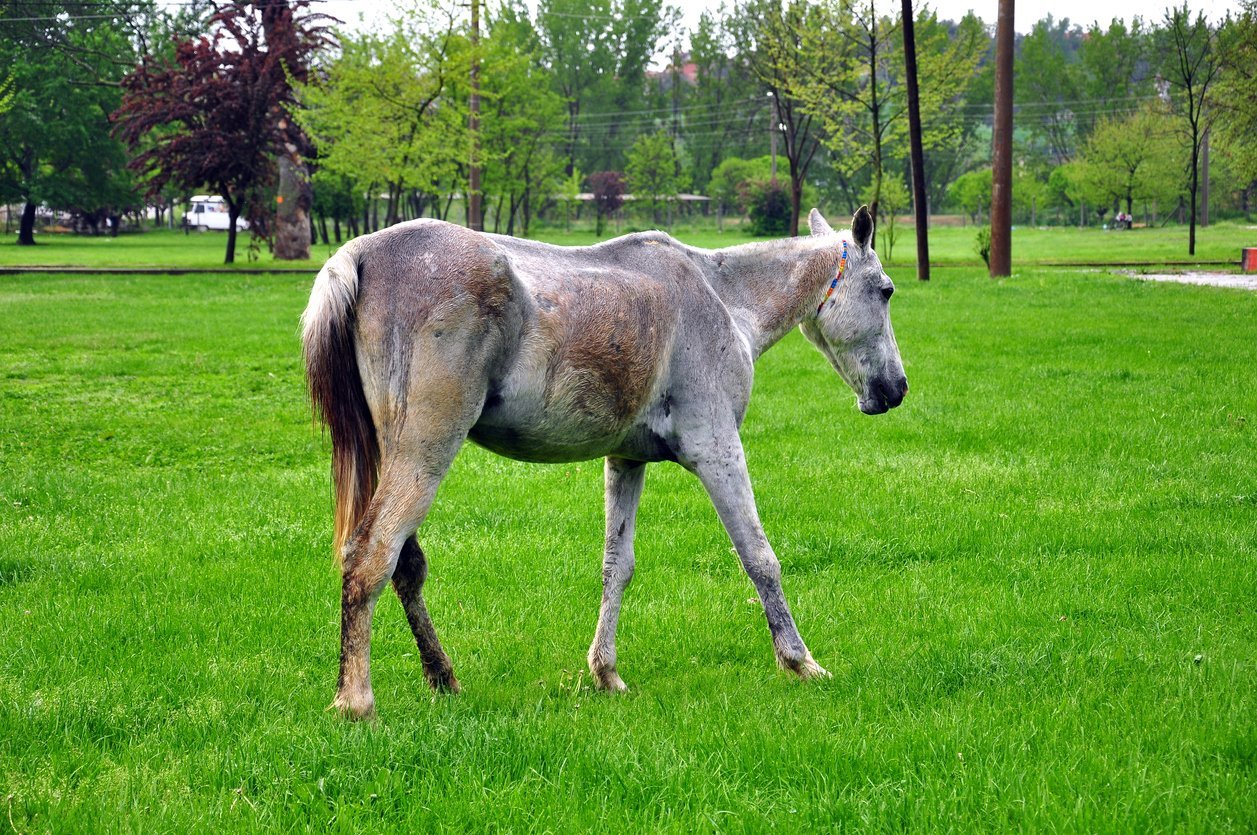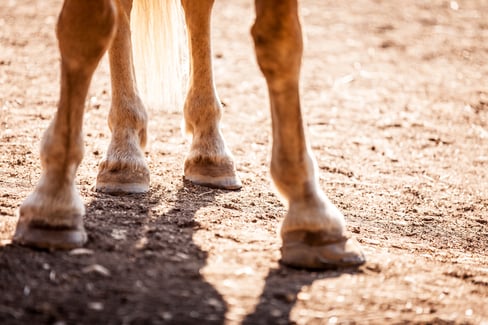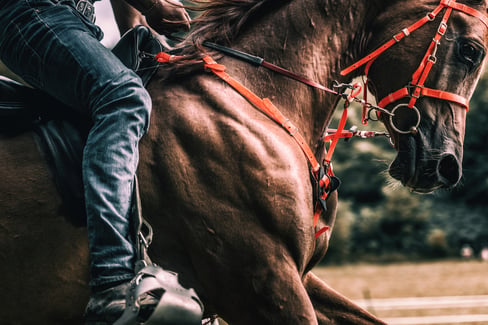Table of Contents
PSSM – aka polysaccharide storage myopathy is a painful but common condition that horses experience – and you need to know everything about it so you can handle it better the next time it comes up.
After all, you don’t want to see your horse in pain.
In order to better understand this condition, as well as the symptoms of PSSM in horses and how to test for PSSM in horses, we’ve compiled all of the essential information in this post.
Ready? Let’s saddle up and get started.
What is PSSM in Horses?
PSSM in horses is a kind of muscle cramping in your horse’s limbs, part of a group of conditions often called “tying-up”. For various reasons we’ll get into later, your horse’s muscles hold on to an abnormal amount of sugar, called glycogen. Horses cannot use this extra glycogen for energy as they exercise. As a result, the horse can face tight, sore muscles and muscle cramps after even just light work.
There are two types of PSSM that each has a different cause:
- PSSM 1 in horses
- PSSM 2 in horses
To understand this condition, we’re going to have to put our lab coats on for a quick biology lesson.
PSSM 1 in horses is sometimes seen as the more straightforward type of PSSM because it has a more defined cause. Horses who experience PSSM 1 have a genetic mutation that affects the glycogen synthase 1 gene, causing it to produce glycogen continually. Think of it like a non-stop production line that doesn’t get the signal to shut down, causing your pal to experience the tight, sore muscles that PSSM in horses is known to cause.
The genetic mutation responsible for PSSM 1 in horses is an autosomal recessive gene. That means that an offspring with a parent with the mutated gene has a 50% chance of inheriting this particular gene.
That’s not to say that your equine’s parentage is the only thing that matters for determining PSSM outcomes.
A few factors that impact PSSM 1 in horses are:
- Diet
- Exercise
- Breed of the horse
When horses who are at risk for PSSM 1 have a poor diet and irregular exercise plans, it can increase the likelihood of facing this condition. Additionally, it has been observed in a higher prevalence in certain breeds, such as quarter horses and related breeds, such as Paints and Appaloosas, as well as draft horses.
PSSM 2 is a little less clear in terms of causation. When vets and researchers looked at the causes of PSSM and took those out of the pool who had the PSSM 1 genetic mutation, they were left with a pool of equines who experienced the symptoms of tying up but didn’t have a clear cause. In essence, a diagnosis of PSSM2 represents those horses in which a muscle biopsy shows clumping of muscle glycogen yet they do not have type 1 PSSM based on genetic testing. In general, type 2 PSSM has the same recommendations for care as type 1 PSSM, since we don’t know what causes it. It is most likely there are several causes of PSSM2 and adopting a breed-specific approach to managing this disease may be the most effective strategy.
PSSM Symptoms in Horses

Spotting PSSM in horses can be hard.
Symptoms of PSSM in horses typically appear by 3 to 12 years of age, but not all cases will present symptoms or instead present ambiguous symptoms that can be mistaken for another condition lumped under the term “tying-up”. That’s why you need to use a careful eye in order to spot PSSM in horses.
PSSM in horses symptoms include:
- Stiffness
- Sweating
- Muscle rigidity after mild-to-moderate exercise
- Reluctant to move under the saddle
- Weakness
- Muscle trembling
- Tail wringing when moving backwards
Severe cases of PSSM may include symptoms such as:
- Coffee coloured urine
- Colicky
- Loss of muscle mass
- Weight loss
- Lethargy
As a result of the shaking and trembling that occurs during PSSM episodes, your horse may become immobile and appear in pain, or as though they have had a seizure. Call your vet immediately if you spot any of the above symptoms, as leaving severe cases of PSSM in horses alone can lead to kidney disease and respiratory failure.
PSSM in Horses Diagnosis
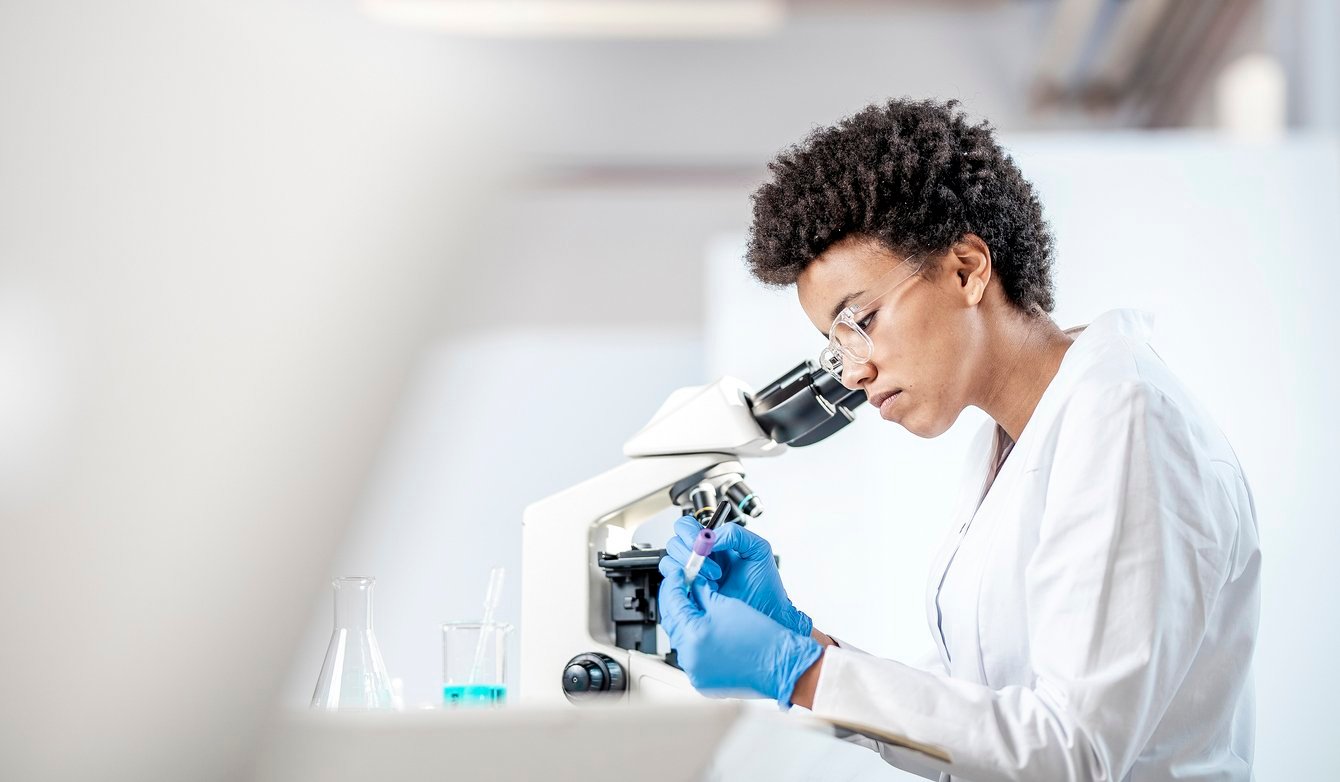
Diagnosing PSSM in horses might seem simple, but as we mentioned, the symptoms of PSSM in horses can be misleading.
That’s why it’s advisable to get your horse tested for the genetic mutation that causes type 1 PSSM.
Genetic testing for PSSM is crucial for determining the best course of action. It can affect decisions from disease management to breeding selection. Veterinary advice should be sought if the PSSM 1 genetic mutation is detected in a horse so that the appropriate diet and exercise routines can be developed and appropriate next steps can be followed.
There are several ways you can test for PSSM in horses. Many universities with large veterinary departments, such as the University of Guelph in Ontario or the University of Minnesota in the US, test for equine neuromuscular diseases in their labs. These tests can be sent to your vet for interpretation. You can also seek out testing through private companies that accept samples often by mail.
No matter who is testing your horse’s genetics, it’s likely that your sample will need to be:
- 20-30 hairs (with roots attached)
- Shipped in an insulated container with freezer packs.
- Sealed (envelope or zippered bag usually)
Similarly, muscle biopsy testing for PSSM 2, or general PSSM in horses testing requires samples to be sent in and examined in a lab setting. This procedure involves a microscopic examination of a muscle biopsy in horses over 2 years of age.
A vet will be able to draw a sample from a muscle in the hamstring area called the semimembranosus muscle. The sample will then be inspected under a microscope using staining to assess how much sugar is stored as glycogen in the muscle.
The table below summarizes the differences between the two types of PSSM in horses testing, and what they determine.
| How to Test for PSSM in Horses | Description |
| Genetic Testing |
|
| Muscle Biopsy |
|
PSSM in Horses Prevention
Of course, you’ll want to prevent PSSM in horses as best as you can. As we said, though, PSSM can be genetic and that means there may not be much you can do to guarantee your horse won’t get it.
That said, there are things you can do to reduce symptoms and prevent the onset of symptoms in your horse.
The three primary things you can do to aid in reducing PSSM symptoms:
- Revise their diet to become low on scratch and sugar
- Provide horse supplements to support muscle and joint health
- Create and execute regular exercise plans
Diet
The diet is the source of so much of your horse’s quality of health and by extension, life. Getting it right is essential.
No pressure for you, right?
Good news! The diet changes that most impact PSSM in horses is pretty simple and fairly effective. Good diet choices start with the right horse feed. Aim to choose an equine feed that is low in sugar and low in starch.
Too much of any of the following ingredients exacerbates PSSM in horses:
- Corn
- Wheat
- Oats
- Barley
- Molasses
Ideally, keep those foods to a minimum. In addition, keeping nonstructural carbohydrates below 12% helps keep blood insulin levels low and reduce muscle glycogen storage. This will aid in preventing the onset of symptoms or even a severe episode of PSSM in horses.
Gradual, small changes that are fine-tuned over time have a huge impact. You can even assemble a team of professionals to care for your horse to make sure you get things right, especially for those horses who may carry the genetic mutation.
One pro you can add to your team – is an equine nutritionist. They can help provide a balanced diet and advice for your unique situation.
Before feeding high-protein feeds to horses with fat pads on their necks, laminitis or sore feet, consult your veterinarian. This is again where that customized guidance from an equine nutritionist can come in handy.
Horse Supplements
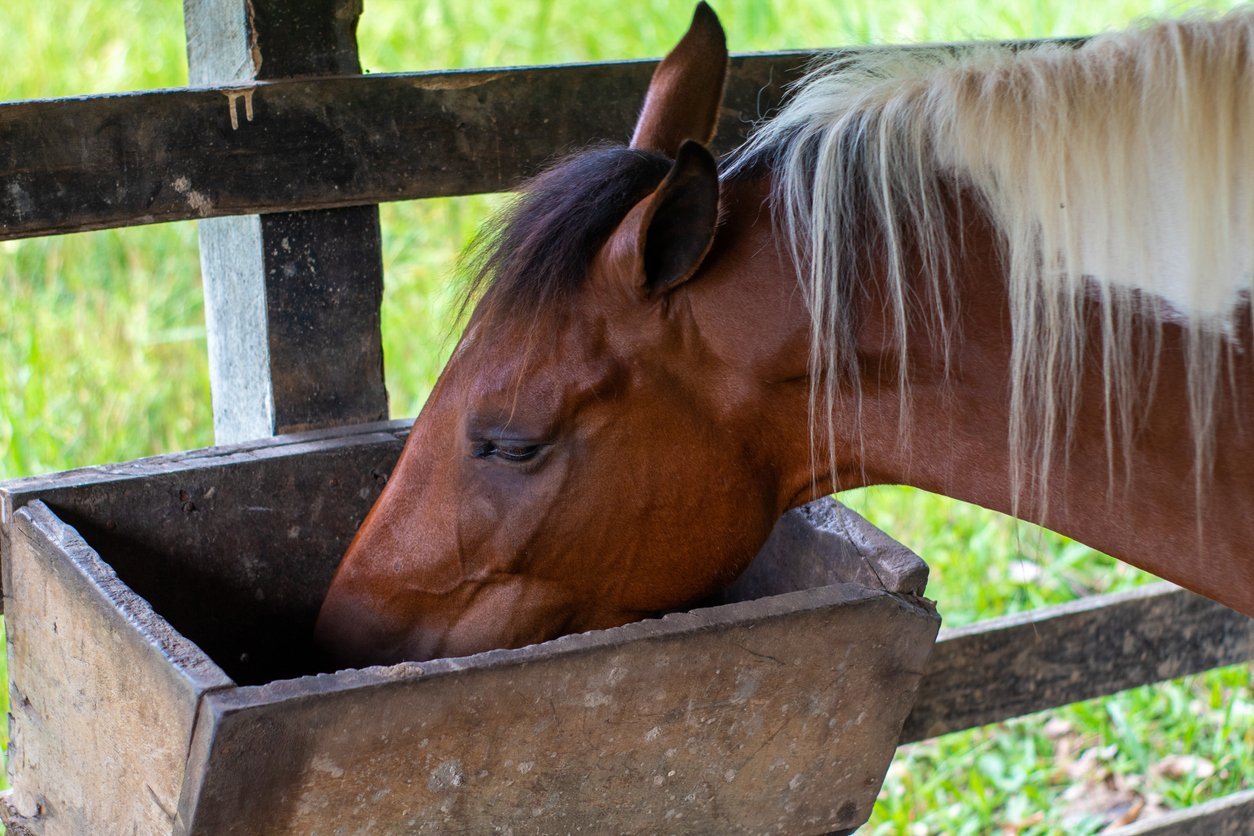
Once you nail down your horse’s diet targeted at PSSM prevention, it’s time to focus on supplementing for success.
When it comes to preventing PSSM in horses, it’s all about supporting healthy muscles and soft tissues. By keeping muscle tissues healthy and strong, as well as reducing inflammation, PSSM symptoms can be reduced or delayed.
The table below details some of the most common kinds of horse supplements for PSSM.
| Dietary Supplements for PSSM in Horses | Description |
| Vitamin E Supplements |
|
| Selenium Supplements |
|
| Joint Supplements |
|
| Magnesium Supplements |
|
Implementing a supplement regimen for your horse can be beneficial in so many ways. From helping prevent other painful conditions like locking stifle to treating a sport horse injury, supplements are helpful additions to any health and prevention plan for horses.
Ensure you choose a high-quality supplement. Start by learning how to read a supplement label, and then look for a joint supplement like Integricare’s TRI-ACTA for Equine which has zero fillers, high-quality ingredients tested for efficacy, and the backing of third-party batch testing. That way, you can trust that your horse is getting exactly what they need, and nothing they don’t!
TRI-ACTA for Equine
Providing preventative support for younger horses and helping mitigate the early onset of joint degeneration and other mobility issues.
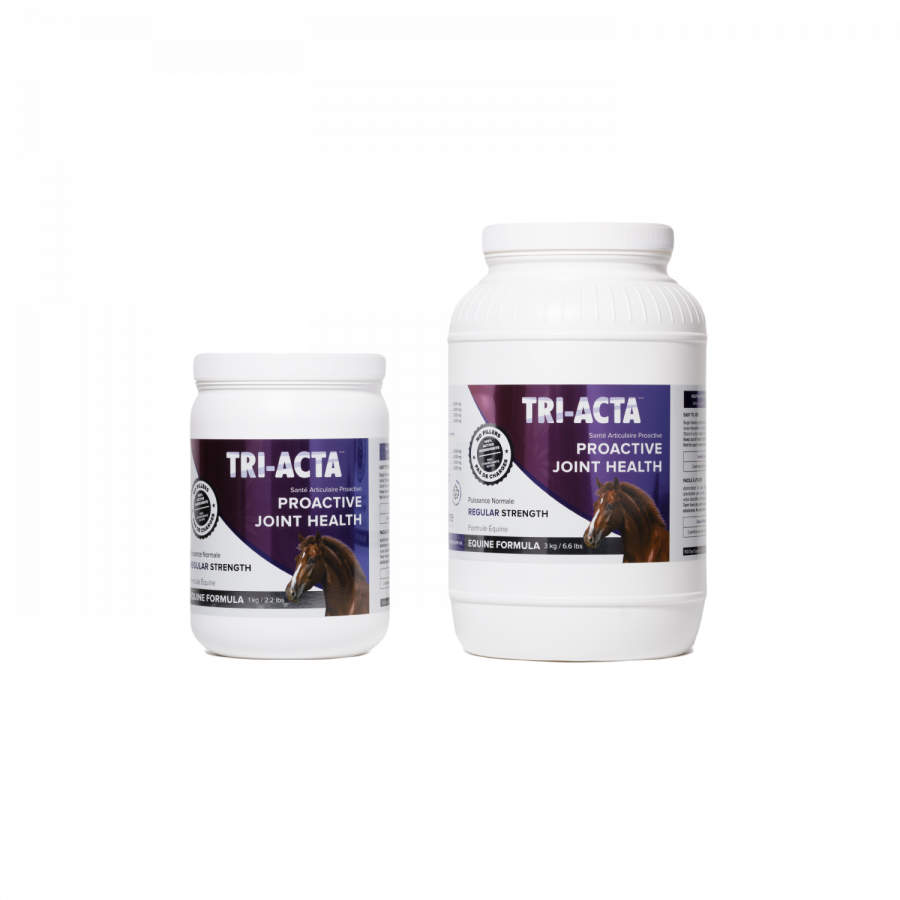
Exercise & Rest
Our lives are all about balance. The same goes for our horses.
We need to balance rest and exercise when it comes to PSSM in horses. Too much of a good thing is, well, no good. Balance the two for the best PSSM prevention.
Rest may not be as helpful as you’d think for severe cases of PSSM in horses. It is believed that prolonged rest is counterproductive and can predispose horses to further episodes of muscle pain. More than 12 hours of stall rest per day increases the risk of tying up for horses, so avoid long periods of confinement for your equine companion whether they have been diagnosed with PSSM or not.
For daily maintenance, turnout in the paddock and gentle hand-led exercise is essential. That’s because exercise can help to break down the extra glycogen stored in muscles. Make sure your horse is spending an adequate amount of time on their fitness, age, and needs. Don’t forget to stretch and warm up your horse properly and to take frequent breaks, especially when working on collecting.
PSSM in Horses Treatment
Unfortunately, there is no “cure” for PSSM in horses. That is largely due to the genetic aspect of this condition. You simply can’t change a horse’s DNA!
Despite the fact that there is no cure for PSSM in horses, the condition is commonly managed through a combination of specialized diet and exercise.
Exercise Rehabilitation
For horses with PSSM, after a severe onset of symptoms, can be painful and scary. You need to get an exercise plan in place to help rehabilitate them. But like we said before, that can be a fine balance. You need to create a gradual return to full exercise, being careful not to overdo it along the way.
The following are a suggestion of steps you can take to help get things back on track when you experience a severe episode of PSSM in horses:
- A 15-minute exercise test from your vet or another equine professional determines the initial training stages.
- It is recommended that the horse spend two weeks on pasture with a change of diet if they fail the test. Horses that successfully pass the exercise test should work on lunging for 15 minutes each day.
- A few minutes of exercise should be added every few days. Each day, warm up and stretch before beginning work with your horse.
- Horses can begin working under the saddle once they can work on lunging for 30 minutes without difficulty. Make sure to give your horse five-minute breaks between sessions.
- After four weeks of walking and trotting, canter work can be introduced.
By following these steps carefully, you can treat your horse for the pain and discomfort they’re experiencing due to PSSM and ensure that they can enjoy a good quality of life without interruptions from an episode.
PSSM in Horses Diet
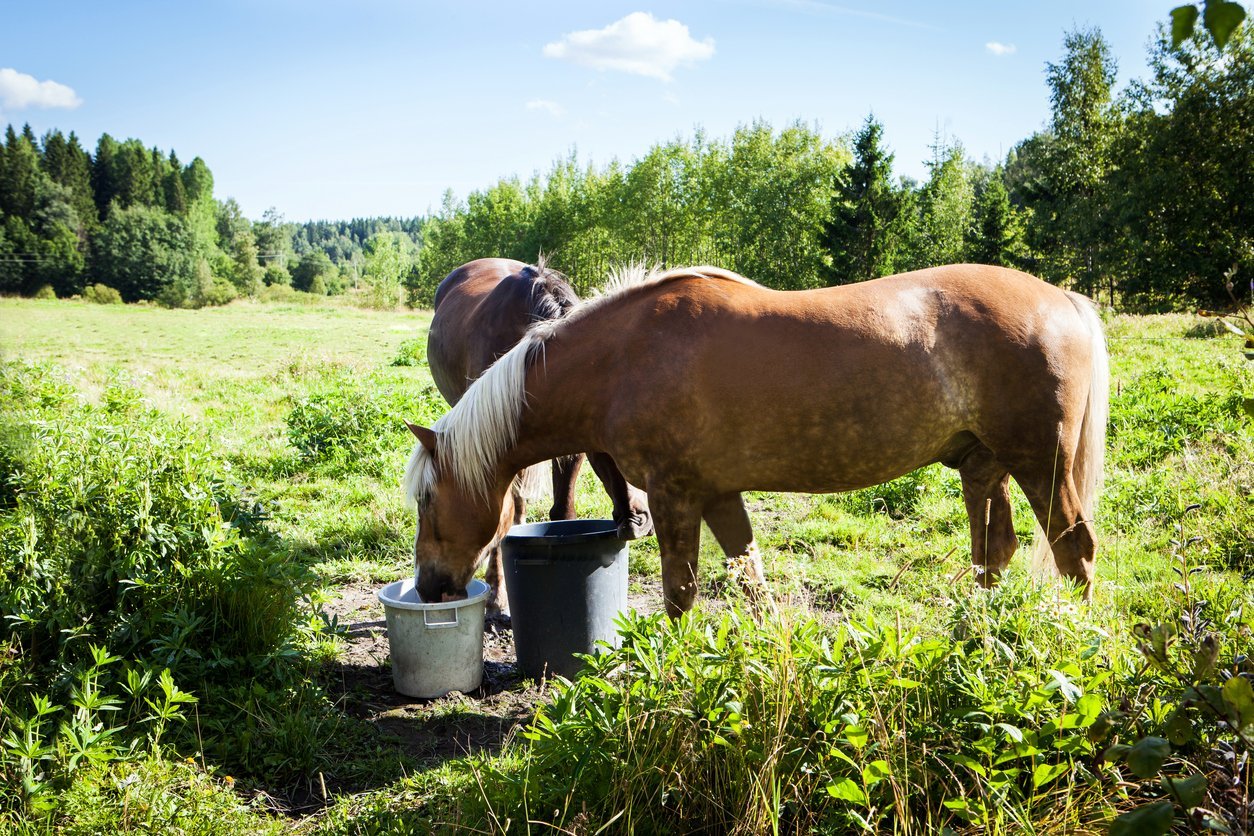
Particularly when treating PSSM 1 in horses, managing a specialty diet is crucial for ongoing wellness. The low starch, low sugar diet that is ideal for prevention is also applicable for treatment, however, there are a few additional things to note when you’re treating an episode of PSSM in horses.
Follow a PSSM in horses’ diet that focuses on:
- Providing hay low in nonstructural carbohydrates (NSC)
- Avoiding high sugar and high starch feed and forage
- Offering a low-calorie ration balancer
- Add fat to their diet for increased energy, if needed
Ideally, hay should contain less than 12 percent NSC, or starch content. It has been shown that forages with greater than 12 percent NSC can cause quarter horses with PSSM to have exaggerated glycemic and insulinemic responses, resulting in potentially dangerous elevations in insulin concentrations. The best thing to use in this situation is hay or haylage, avoiding lush grass.
Sending your horses to pasture for turnout is a great way to get the exercise and movement that your horse needs to keep their muscles supple. However, you need to keep in mind the sugar content of the pasture they are eating. Lush, sweetgrass is very high in sugar and starch, so ensuring that your horse doesn’t consume too much is crucial. Grazing should be restricted either by moving to another pasture, dry lot or by using a grazing muzzle.
Similar to restricting the consumption of lush pastures, calorie intake must be managed for PSSM in horses. Horses with PSSM are known to be “easy keepers”. This means they gain weight easily, even under conditions where other horses will lose weight. Caloric intake should be reduced, if necessary, by providing low-NSC hay at 1 to 1.5% of body weight and a low-calorie ration balancer, alongside daily exercise.
The type and amount of fat that should be added to a horse’s diet depends on the individual horse, his weight, and his owner’s budget. Horses can get cranky when they don’t have enough fat in their diet, so make sure you give your equine pal a little bit of fat to keep them moving and happy.
Suitable oils to add to a PSSM in horses’ diet:
- Soybean
- Corn
- Safflower
- Canola
- Flaxseed
- Linseed
- Fish
- Peanut
- Coconut
Gradually adding oil to the horse’s diet should be done while monitoring exercise tolerance and weight. Generally, the recommended amount of oil for your horse is usually between 1/2 and 2 cups. As an alternative to providing dietary fat to those “easy keepers”, fasting for six hours prior to exercise can be useful for elevating plasma-free fatty acids and alleviating any restriction in energy metabolism in muscles.
Q&A
It’s common to have questions about managing conditions your horse is facing. You’re just doing the best you can to care for them, after all. So we’ve got the answers to the most common questions asked about PSSM in horses.
How Serious is PSSM in Horses?
PSSM in horses can be a very serious problem, and in severe cases, a horse may be unable to stand and be uncomfortable even when lying down. Such horses often have coffee-coloured urine, because muscle proteins are released into their bloodstream and then pass through into their urine. This can cause serious kidney damage to the horse. You can also risk respiratory failure if the PSSM in horses goes unchecked.
The good news is that around 70% of horses show significant improvement with diet and exercise programs if the regimens are followed properly. That means you can avoid the truly serious symptoms and side effects if you act swiftly and effectively alongside your vet to make sure your equine companion is healthy and happy now and in the future.
How to Test for PSSM in Horses?
There are two ways to test for PSSM in horses
- Genetic testing
- Muscle biopsy
Genetic testing is ideal for horses who are suspected of having PSSM 1, the genetic mutation variant of PSSM in horses. A small hair sample with roots attached is sent to a lab to be processed and tested for the presence of the mutation.
Muscle biopsy testing is effective at testing horses who have already been tested for PSSM 1, and do not carry the gene. A small cross-section of muscle is removed from the horse’s hindquarters and sent for inspection at a lab. This will identify the presence of PSSM in horses, but unfortunately, as PSSM 2 has no known cause, will not be able to explain why it’s the case.
Research continues to seek answers to this mysterious condition, in hopes of one day finding an answer to why it occurs.
Newsletter Signup
Subscribe to our newsletter to receive the latest news and exclusive offers.
.jpg?height=2000&name=Cliick_Integricare-DISPLAY-REVISEDV2%20(1).jpg)
Proactive & Therapeutic Joint Supplements
When given daily, Integricare joint supplements recover bone and joint injuries faster and help prevent mobility injuries from happening in the first place.

